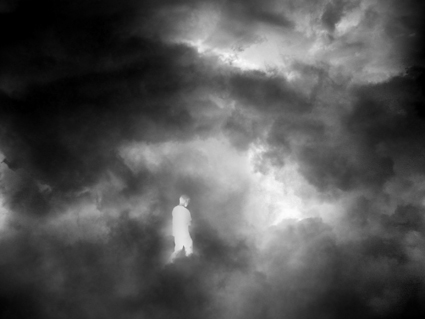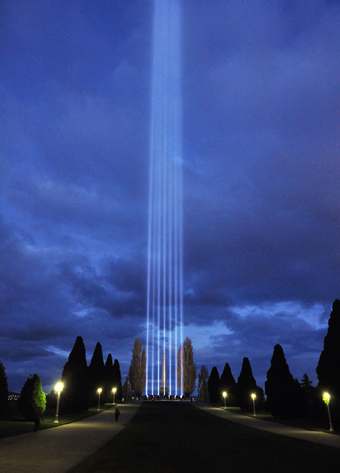The eye looks inward
Judith Abell: MONA, Dark Mofo

Kurt Hentschlager ZEE Beam In Thine Own Eye – Dark Mofo 2013, MONA
image courtesy the artist
Kurt Hentschlager ZEE Beam In Thine Own Eye – Dark Mofo 2013, MONA
Within a minute of entering Zee, I feel panic rising in me like a wave of nausea and, review or no review, I am out. It is unsurprising given the warnings at the entry, the attendant’s verbal description and the waiver I signed, but still, this artwork has triggered something in me I didn’t know existed.
The work—where the participant is immersed in a theatre-fog-filled environment dominated by strobe light—is by Kurt Hentschlager and is part of Beam in Thine Own Eye (BITOE), a curated exhibition for the Dark Mofo festival. Here, installations by 15 artists are selected to affect rather than for effect.
Originally biblical (Matthew 7:3), the show’s title is reinterpreted by David Walsh and his curators to evoke the real and flawed self, shining from within—the mind’s eye. My newfound fear—garden-variety claustrophobia or not—seems to be a resident within this internal reality.
Ivana Frank’s We Close Our Eyes and See a Flock of Birds draws me back to lengthy childhood hours exploring the space behind my eyes. Here, up to five people are admitted to a small cylindrical space. We sit facing the curved inner wall, its surface studded with LEDs. With eyes closed, the combinations of flashes across this wrapping grid offer up a continuous light show behind our lids. Colours change, patterns emerge and condense, clear imagery is elusive. I do not see birds, but others note glimpses. Each observation is slightly different.
Introducing this effect more gently, Anish Kapoor’s Imagined Monochrome is a calm treat. I book days ahead for my 20-minute massage ‘by’ this celebrity artist. Under his written instruction, a trained masseuse works my arms, neck and head while I lie with eyes closed in a white room under a bright light. Some minutes in, it is as though I shift into another visual space where bright colours flash, coloured orbs pulse. I am once again that childhood explorer, but unlike in Frank’s piece, here I have time to ponder what Kapoor describes as “the prisoner’s cinema.” At the end, eyes covered by the masseuse, I ‘see’ a field of blue and experience a sense of resolution as though this entire performative work were structured in order to allow me to access this unambiguous ‘other’ space.
Across Sullivan Cove, Sound to Light is a collection of collaborative outcomes installed and performed within the upper floors of the Salamanca Arts Centre. It has a decidedly underground feel when compared to its big cousin BITOE. The opening night is a crowded, slightly chaotic experience where it is easy to miss key performative moments while lost in the maze of exhibition rooms, but several works remained installed afterward. Composer Dylan Sheridan and artist Laura Hindmarsh’s Between Attraction and Monstration is a quiet, delicate piece best experienced alone. As I stand within a semicircle of tall, narrow, paper screens, light and film projection shift between moments of collaged film imagery and my own flickering shadow. I feel like a fragment of early, experimental film.
Equally enjoyed alone, The Geometry of Innocent Flesh on the Bone is a collaboration between artist Oscar Ferreiro and composer Heath Brown where robotic devices are strapped to sections of bone, mounted to the back of a plywood ‘animal.’ Surface mikes on the robotics feed sound back into the work composed by Brown. Deep, regular pulses within the composition, layered against the irregular, robotic squeaks of the devices, create the illusion that I share a lair with sleeping beasts.

Ryoji Ikeda, spectra tasmania, photo Rémi Chauvin
image Courtesy MONA
Ryoji Ikeda, spectra tasmania, photo Rémi Chauvin
Breaking apart the closed space of other Dark Mofo works, Ryoji Ikeda’s spectra affects the entire Greater Hobart population. Located at the Cenotaph, the public artwork is formed from a grid of 49 powerful xenon searchlights directed to the heavens. From sunset the work builds in strength to the point where lights beam 15kms into the night sky and the distinctive ‘ping’ within the accompanying digital soundscape seeps into homes across the city. This is an undeniably sublime artwork from a distance, but best experienced up close. Rugged up against the wind and rain, hundreds of people stand in and around the work gazing skywards. I visit on the opening and subsequent nights and the shared reaction is one of quiet delight, as people explore this ephemeral cathedral. It is at its most magnificent in driving rain, when the texture of each raindrop is illuminated and night rainbows form along the column of light. Social media feeds repeat the plaintive “I will miss you spectra” in the days after its closing.
With plentiful night hours, winter is the perfect time for works like these. It is almost as though the dark cavern that is MONA has elastically stretched to encapsulate all of Hobart, such that we encounter art at every turn and works with light create shifts in our internal and external realities. While many works are affecting, I am certain the apocalyptic beam of spectra will be the visual and spatial memory that stays with us all as a collective index for this first Dark Mofo festival.
MONA, Events Tasmania, Hobart City Council: Dark Mofo, Hobart, 13-23 June
RealTime issue #116 Aug-Sept 2013 pg. 26






